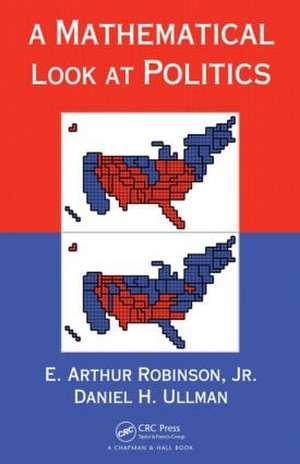A Mathematical Look at Politics
Autor Jr. Robinson, Daniel H. Ullmanen Limba Engleză Hardback – 9 dec 2010
A Mathematical Look at Politics is designed as an alternative to the usual mathematics texts for students in quantitative reasoning courses. It applies the power of mathematical thinking to problems in politics and public policy. Concepts are precisely defined. Hypotheses are laid out. Propositions, lemmas, theorems, and corollaries are stated and proved. Counterexamples are offered to refute conjectures. Students are expected not only to make computations but also to state results, prove them, and draw conclusions about specific examples.
Tying the liberal arts classroom to real-world mathematical applications, this text is more deeply engaging than a traditional general education book that surveys the mathematical landscape. It aims to instill a fondness for mathematics in a population not always convinced that mathematics is relevant to them.
| Toate formatele și edițiile | Preț | Express |
|---|---|---|
| Paperback (1) | 349.39 lei 6-8 săpt. | |
| CRC Press – 14 oct 2024 | 349.39 lei 6-8 săpt. | |
| Hardback (1) | 683.87 lei 6-8 săpt. | |
| CRC Press – 9 dec 2010 | 683.87 lei 6-8 săpt. |
Preț: 683.87 lei
Preț vechi: 804.55 lei
-15% Nou
Puncte Express: 1026
Preț estimativ în valută:
130.87€ • 135.80$ • 109.39£
130.87€ • 135.80$ • 109.39£
Carte tipărită la comandă
Livrare economică 15-29 martie
Preluare comenzi: 021 569.72.76
Specificații
ISBN-13: 9781439819838
ISBN-10: 1439819831
Pagini: 478
Ilustrații: 14 black & white illustrations, 45 black & white tables
Dimensiuni: 156 x 234 x 30 mm
Greutate: 0.84 kg
Ediția:1
Editura: CRC Press
Colecția CRC Press
Locul publicării:Boca Raton, United States
ISBN-10: 1439819831
Pagini: 478
Ilustrații: 14 black & white illustrations, 45 black & white tables
Dimensiuni: 156 x 234 x 30 mm
Greutate: 0.84 kg
Ediția:1
Editura: CRC Press
Colecția CRC Press
Locul publicării:Boca Raton, United States
Public țintă
PostgraduateCuprins
Preface, for the Student. Preface, for the Instructor
Voting
Two Candidates. Social Choice Functions. Criteria for Social Choice. Which Methods are Good? Arrow's Theorem. Variations on the Theme. Notes on Part I
Apportionment
Hamilton's Method. Divisor Methods. Criteria and Impossibility. The Method of Balinski and Young. Deciding Among Divisor Methods. History of Apportionment in the United States. Notes on Part II.
Conflict
Strategies and Outcomes. Chance and Expectation. Solving Zero-Sum Games. Conflict and Cooperation. Nash Equilibria. The Prisoner's Dilemma. Notes on Part III
The Electoral College
Weighted Voting. Whose Advantage? Notes on Part IV. Solutions to Odd-Numbered Exercises and Problems. Bibliography. Index
Voting
Two Candidates. Social Choice Functions. Criteria for Social Choice. Which Methods are Good? Arrow's Theorem. Variations on the Theme. Notes on Part I
Apportionment
Hamilton's Method. Divisor Methods. Criteria and Impossibility. The Method of Balinski and Young. Deciding Among Divisor Methods. History of Apportionment in the United States. Notes on Part II.
Conflict
Strategies and Outcomes. Chance and Expectation. Solving Zero-Sum Games. Conflict and Cooperation. Nash Equilibria. The Prisoner's Dilemma. Notes on Part III
The Electoral College
Weighted Voting. Whose Advantage? Notes on Part IV. Solutions to Odd-Numbered Exercises and Problems. Bibliography. Index
Notă biografică
E. Arthur Robinson Jr., Daniel H. Ullman
Recenzii
The book finds a nice compromise between formality and accessibility. The authors take care to build from examples, isolate what is important, and generalize into theorems. It is expected that the reader has only limited mathematical experience, so much effort is put toward making very clear what is and is not being said. … The exercises that close each chapter are interesting and often quite challenging … Topics are introduced and motivated thoughtfully. Definitions are clear, and the authors take the time to explain why they need to be with well-chosen examples. When the proofs come (and they do come), they are set up properly. … The book has plenty of uses other than as a textbook. Instructors teaching a broader liberal arts mathematics course could use it to add depth to these topics or craft supplemental readings and projects. Students of mathematics or politics will find independent study opportunities here, and mathematicians from other areas will find this an enjoyable introduction. This is a very thoughtfully written text that should be made available to anyone with an interest in learning or teaching this topic.
—MAA Reviews, July 2011
Tying the liberal arts classroom to real-world mathematical applications, this text is more deeply engaging than a traditional general education book that surveys the mathematical landscape. It aims to instill a fondness for mathematics in a population not always convinced that mathematics is relevant.
— BULLETIN BIBLIOGRAPHIQUE, 2011
—MAA Reviews, July 2011
Tying the liberal arts classroom to real-world mathematical applications, this text is more deeply engaging than a traditional general education book that surveys the mathematical landscape. It aims to instill a fondness for mathematics in a population not always convinced that mathematics is relevant.
— BULLETIN BIBLIOGRAPHIQUE, 2011
Descriere
With record voter turnouts for the 2008 presidential election, interest in the U.S. electoral system and voting (especially among college students) has never been higher. This textbook is based on a popular mathematics and politics course that the authors have taught at George Washington University for the past six years. It explores the mathematics of politics, showing how mathematical reasoning is connected to the pressing issues of contemporary politics and in the liberal arts. Focusing on voting, apportionment, conflict, and the Electoral College, each part of the text examines a type of decision problem and a way to solve it.
